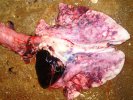Actinobacillosis
Actinobacillosis is caused by a systemic bacteria that affects many farms that have high health issues causing arthritis, pneumonia, or skin discoloration in animals of all ages.
Alternative names: Actinobacillus suis, Actinobacillus equuli
Information
It is mainly caused by the bacterium called Actinobacillus suis and in rare occasions by Actinobacillus equuli. The first of these is present in most farms and lives in the tonsils of older pigs, especially in sows.
Symptoms
Sows
- Skin discoloration.
- Abortion.
- Pneumonia.
- Septicemia.
Lactating piglets and weaners
- Sudden death.
- High fever.
- Pneumonia.
- Skin discoloration.
- Skin lesions (not to be confused with erysipelas).
- Arthritis.
- Lameness.
- Septicemia.
Growers
- Rarely seen.
- The same as in piglets.
Causes / Contributing Factors
- It can be triggered by PRRS.
- It can infect the pig through the respiratory system or through cuts or abrasions.
- It spreads systemically and it can be found in various parts of the body, especially in lungs and joints; multiple small abscesses are produced here.
Diagnosis
- Clinical signs and history of high health herd; negative to Actinobacillus pleuropenumoniae (APP)
- Culture.
- Necropsy.
- Must rule out erysipelas and APP which both tend to affect a large number of pigs.
Control/Prevention
- The organism is sensitive to antibiotics.
- Strategic use of medication.
- Possible use of autogenous vaccines.








